Museums and Exhibitions in New York City and Vicinity
| Home | | Museum Guide | | International | | Architecture and Design | | Theater |
GLENN LONEY'S MUSEUM NOTES
CONTENTS, February 1, 2004
[01]Chuck Close Prints at the Met
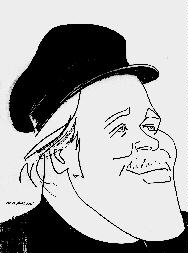
Caricature of Glenn Loney
by Sam Norkin.
[02] Met's Old Kingdom Tombs
[03] PLAYING WITH FIRE: European Terracotta
[04] Italian Mythological Prints at Met
[05] BRAVEHEARTS: Men in Skirts
[06] Philip Guston at the Met
[07] Lucas Samaras at the Whitney
[08] John Currin also at Whitney
[09] Whitney's Arshile Gorky Retrospective
[10] Parmigianino at the Frick
[11] Fellini at the Guggenheim
[12] Charles Bargue at Dahesh
[13] Reframing Academic Art
[14] SF EXPLORATORIUM© at American Museum
[15] EMPAC Planned for Troy
[16] Seismic Changes for Berkeley's Bancroft Library
[17] Cincinnati's Art Deco Union Terminal
[18] On View at Cincinnati Art Museum
[19] New Cincinnati Wing
[20] Women Artists in Cincinnati
[21] Proctor and Gamble's Arts Gift
[22] Zaha Hadid's Cincinnati Center for Contemporary Art
[23] Cincinnati's BATS INCREDIBLE!
You can use your browser's "find" function to skip to articles on any of these topics instead of scrolling down. Click the "FIND" button or drop down the "EDIT" menu and choose "FIND."
For editorial and commercial uses of the Glenn Loney INFOTOGRAPHY/ArtsArchive of international photo-images, contact THE EVERETT COLLECTION, 104 West 27th Street, NYC 10010. Phone: 212-255-8610/FAX: 212-255-8612.
Copyright © 2004 Glenn Loney.
For a selection of Glenn Loney's previous columns, click here.
·On View at the Metropolitan Museum of Art:
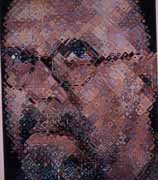 |
| CHUCK
CLOSE UP-CLOSE--Self-Portrait Print at Met Museum. |
·CHUCK CLOSE PRINTS: Process and Collaboration
[Closing April 18, 2004] This is a small-scaled but nonetheless visually overpowering show. That is partly owing to the immense size of some of the process-series of Chuck Close's prints. But it's also a function of the pixel-power way in which Close has broken up head-shots of himself, Philip Glass, and others into grids or blobs of color. Seen from a distance, these discrete entities blend into powerful portraits. Artists Alex Katz and Lucas Samaras—who has a notable self-referential show at the Whitney—have also been portrait-subjects.The spinal aneurysm which confined Close to a wheelchair and limited his physical abilities to make artworks has had a rare kind of dividend in encouraging him to find new ways to see and to create. As well as to collaborate with other artists, printmakers, and technicians in adapting venerable traditions in silk-screening, etching, engraving, and even Japanese print-making skills to fulfill his optical visions.
One of the astonishing developments has been Close's innovative work with Pulp Paper Multiples. Even the complex metal-stencil—made to separate different shades of pulp on the carrier-sheet of a potential portrait—becomes an artwork in its own right. Blobs of different shades of pulp Close later began to use to form collaged portraits, as with the image of his daughter Georgia.
From his early days as a fledgling artist—as the exhibit notes—Close was interested in such historic print technique as mezzotint and aquatint. So the much newer large-scale prints—shown in a number of stages in the process of completion—are building on an earlier foundation. And Close has also been aided by various groups of sensitive, intuitive artist-technicians to realize his portraits.
He couldn't have made these marvelous images alone, and the virtue of dedicated collaboration on these projects shows.
·OLD KINGDOM TOMBS
Not Shielded by Glass Six Weeks Only!
[Until Mid-March 2004]
People are standing in line at the Met to look at Egyptian tomb reliefs which are almost 4500 years old. This might seem a bit strange, as the tombs of Perneb and Raemkai have been in place in the Egyptian Galleries for some time now. What makes them so interesting at the moment is that for a very brief time the rich red colors on the mortuary carvings and the outlines of the delicate hieroglyphics can be seen without protective glass-panels. Previously—and again, very soon—these were somewhat obscured by the reflections of the glass. The problem—both for these antiquities and for the potential viewers—is that the inner sanctums of both tombs are very narrow so only a few people can see them at any one time. Even then, there is the danger of brushing against a relief in turning around in the confined spaces to study the opposite wall.
This is not exactly Hands-On, but at least you can have a more immediate experience of Ancient Egypt than before. In fact, all of the Egyptian Galleries have been renovated and rethought, with a view to making the collections more impressive, more accessible, and more understandable to viewers.
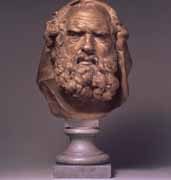 |
| BUST
OF BEARDED ELDER--Augustin Pajou's Met terracotta may be sneering at you! |
·PLAYING WITH FIRE:
European Terracotta Models/1740-1840
[Closing April 25, 2004]
Actually, some of the sculptors' terracotta models on display at the Met were never fired. They were rapidly made, almost like sketching in clay, to capture a vision or outline an important commission. Later, when the project had taken more definitive form in a sculptor's mind, a newer, more precise model could be made—and fired—to use as a guide for carving of the actual sculpture. This would usually be much larger than the clay model, though some portrait-bust models were not reduced in size. In the current show, some of the most interesting of the models are those which show an almost slapdash inspiration of the artist, instantly capturing in broad strokes of a knife or molding tool the broad outlines of the proposed sculpture. For some complicated Neoclassic monumental projects, it's also amazing, in such early stages, how sculptors were able to suggest intricate decorative details such as swags, triumphs, and reliefs with rapidly-worked bits of damp clay.
Although this show has been deployed in the small galleries between the great Greek and Roman corridor and the long atrium-hall which joins the early Met with the more recent additions, it contains far more objects d'art than most exhibitions previously in the space. This is thanks not only to the generally small-scale of most of the terracottas, but also to the fascinating labyrinth-maze in which they have been displayed.
Many of the works are by sculptors who either lived and worked in Rome, or who studied and worked there for a time before returning to Germany, France, or, in the case of the brilliant Johan Tobias Sergel, to his native Stockholm. One of the old Stockholm city gates is in fact named Sergels-Torg.
Among the notable sculptors whose models are on view are Canova, Chinard, Roland, Dannecker, Clodion, David d'Angers, Schadow, and Pajou. Their models are to be found in more than one thematic section of the show, which focuses initially on the actual process of making models. Funerary and Historical Monuments, Portrait Busts, Bacchic Revels, Greek and Roman Heroes and Heroines, and Mythology all are given their due. One of the most arresting is Sonnenschein's model of the monument to Frau Langhans and her Stillborn Child.
This is an exhibition which invites contemplation. So many of the delicate details of the models really encourage close examination. How could they achieve that so fast in such a small piece of wet clay—before it dried out? A magnifying-glass would be a good study-aid to bring along when you come to the Met for this show!
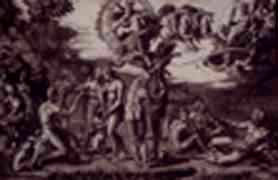 |
| WHO GETS THE GOLDEN APPLE?--Italian print
of Mythic Judgment of Paris, now at the Met Museum. |
·POETS, LOVERS, AND HEROES
In Italian Mythological Prints
[Closing May 2, 2004]
In the beautiful Mirabell Gardens in Austrian Salzburg, a wonderful green-patina Pegasus rises out of a baroque fountain, its wings spread for take-off. It took a recent trip to the Met Museum and its new Mythological Print exhibition to remind me why this statuary-placement is so apt. In Classic Mythology, when Perseus stroke off the deadly snake-haired head of the Medusa, the winged-horse Pegasus arose from her blood. Soon after, Pegasus created the Hippocrene Spring, font of the Nine Muses! What better image to place on a major fountain than the famed Flying-Horse!
If you have ever read Gayley's Classic Myths or Ovid's Metamorphoses, you will surely be delighted to rediscover some of the most famous of these stories of Gods and Mortals in Italian Myth-Prints from the Renaissance into the 19th century now at the Met.
But this fascinating show is not only about the Labors of Hercules, the Loves of Cupid/Eros, the Fall of the Giants, the Flaying of Marsyas, the Feats of Perseus, the Judgment of Paris, the Orgies of Bacchus and Silenus, or the Ovidian Transformations of Daphne, Narcissus, and Syrinx. It is also a survey of some of the finest mythical fantasies and compositions of major artists—not only Italian, but all working in Italy—transformed from sketches into woodcuts, etchings, and engravings.
The importance of the development of print-making in the Italian Renaissance was the possibility for the first time of a wide audience being able to afford images of great artworks previously only accessible to rich patrons. Among the artists represented in the current show are Annibale Carracci, Domenico Tiepolo, Salvator Rosa, Andrea Mantegna, Ugo da Carpi, Giorgio Ghisi, Stefano della Bella, Marcantonio Raimondi, Pietro Testa, Claude Lorraine, and Melchior Meier.
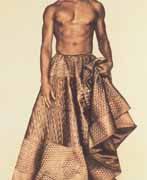 |
| MAN IN
SKIRTS--Jean Paul Gaultier design on view at Met Costume Institute Bravehearts
show. |
·BRAVEHEARTS: Men in Skirts
[Closing February 8, 2004] This provocative show from collections of the Met's Costume Institute and from some major modern designers takes its title from that Mel Gibson film, Braveheart, which celebrated the historic courage of kilt-wearing Scottish warriors. Even in Flanders Fields in World War I, the fierce Scots regiments were known as The Ladies from Hades.
And even today, major Athenian monuments are guarded by Greek soldiers wearing their traditional short, multi-pleated, white skirts. 2500 years ago, Athenians also wore loose-fitting garments which were more like gowns than anything men have been wearing in the West for the past 400 years. But certainly long robes were popular in the Dark and Middle Ages, and some orders of monks still cling to such robes.
In Africa, the Middle East, and in Asia, various forms of robes or gowns are signatures of traditional dress for males. The argument is made in this show that short skirts for men help to show off a powerful masculine leg, which is certainly true of both Greek and Scots soldiers. Even as trousers began to replace tight-fitting hose for men's legs, they often were cut to cling to the limbs.
With the Hippie rebellions of the 1960s and later transgressive reactions to traditional western suits, skirts specifically designed for men have become media-worthy fashion-statements. The current show, in fact, is really more about this and its leading design-advocates than it is about the history of Men in Skirts. That the exhibition has been sponsored by the cutting-edge French male-skirt-designer Jean Paul Gaultier underscores this emphasis.
There are over 100 examples of skirts for men on view at the Met!
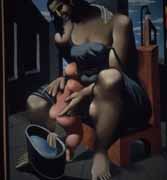 |
| PHILIP
GUSTON'S 1930s VISION--Mother & Child, with overtones of DiChirico & Picasso. |
·PHILIP GUSTON
[Closed January 4, 2004] If you missed Philip Guston's Retrospective at the Met, you can catch it at the Royal Academy of Arts, but only until April 12. Or you can have the effect of seeing the show—on a much smaller scale—by studying the $50 Thames and Hudson catalogue: PHILIP GUSTON RETROSPECTIVE. This fine volume has 197 illustrations, 158 of them in color.For those who have followed the development—and even "the decline" as some might insist—of Guston's work over the decades, the organization and display of the Met's showing of his creations certainly makes his different styles and impulses quite clear.
For those fond of Figurative Painting, the young Guston's drawings and paintings were impressive in their observation, composition, and technical execution. Guston's work as a politically-charged mural painter—influenced by Modern Mexican Masters and WPA Art Deco examples—is still powerful.
But he moved on to a delicate and suggestive form of Abstract Expressionism which was as alien as possible to the muralist-phase. These works have a special power of their own, which owes nothing to mural-images.
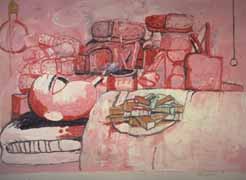 |
| PHILIP
GUSTON AFTER ABSTRACTION--Cartoonish vision of artist in painting, Smoking,
Eating. |
The most powerful Guston images, however, are those he began to create when he withdrew from the New York artworld and found a new use for the comic-strip cartoons he had so long loved. Some of these bold, garish paintings alienated former friends and admirers, but they won for Guston a new following for their gritty resonances with life lived in a cartoonish world. Many of these—excepting a scary vision of Richard Nixon at San Clemente—are self-referential, including Ku Klux Klan images which apparently had personal as well as political resonances.
·Novelty at the Whitney Museum of American Art:
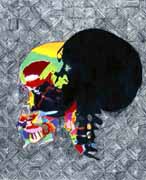 |
| LUCAS SAMARAS' LOVE-AFFAIR--"Large drawing #39", 1966, Lucas Samaras. Whitney Museum of American Art, New York. Gift by Howard and Jean Lipman. |
·UNREPENTANT EGO:
Self-Portraits of Lucas Samaras
[Closing February 8, 2004]
The invention of the Polaroid Land Camera was a god-send to Lucas Samaras. Otherwise, he might have lived out his artistic-life creating pin-sprinkled mystery-boxes in the spirit of Joseph Cornell. Instant images thanks to Polaroid permitted Samaras to photograph himself—and parts of himself, as well as friends—over and over. The current show at the Whitney is crammed with almost 400 Samaras artworks, most of them self-portraits in various media, sizes, attitudes, locales, styles, colors, and facial-hair.
Actually—as with Chuck Close's giant portrait-prints at the Met—a whole wall filled with large repeats or process-prints of the Lucas Samaras visage can be fairly impressive. It's a matter of scale, rather than subject-matter or artistic-medium.
There are also a number of Samaras constructions in the show, mainly his distinctive boxes. Although Cornell preceded Samaras with the novelty of a compartmented box variously decorated with small objects and collaged scraps of two-dimensional images, Samaras has gone far beyond. Many of his glittering boxes—unlike Cornell's open box-as-frame and focus—have hinged lids or triptych-like wings, plus odd slide-out drawers filled with mysterious and common-place objects.
Although Samaras is fond of gluing rainbow-colored yarn on his boxes, glued masses of silver pins are virtually a Signature, and a dangerous, forbidding one at that. [DO NOT PICK UP THIS BOX! AT YOUR PERIL!]
Fortunately, Samaras has developed a far more felicitous and decorative use for pins. Many of his boxes and other constructions delicately deploy pins in grids, patterns, or pictorial outlines which lends a spatial dimension to flat images.
·JOHN CURRIN
[Closing February 22, 2004] A quick tour of the John Currin show at the Whitney might encourage Freudians to believe the painter was breast-fed and loved it. Or that he was weaned too soon and never got over that trauma. Female breasts—especially in their over-inflated incorporation in American women and girls—obviously obsess him.This can, however, be partly explained by Currin's fascination with the cartoonish in our Popular Culture, as well as its over-riding sexual obsessions. As recorded in an interview in the press-kit, Currin is alert to the trashy in American Art and Life, and he's inclined to satirize it on canvas.
But balancing the garish/cartoonish in some of Currin's paintings is another influence—even an over-arching obsession—the Painterly Mastery of Great European Artists, especially those of the Renaissance. In fact, in the interview, Currin mourns his inability to paint the Great American Masterpiece, partly because he fears no one can do it, given the circumstances of American Life and Culture.
In fact, he believes no current modern European artist can create Masterpieces any longer either. The reasons he offers for this view of the artist's challenge on both sides of the Atlantic is highly original, quirky even, like some of his paintings. Although Currin's comments on art and artists sometimes seem contradictory, off-the-cuff—it was an interview, after all—he is obviously very well-versed in Art History and knows whereof he speaks.
For lovers of Figurative Art, John Currin could become an ikon—if he wasn't so intent on undermining his brilliant painterly evocations of Lucas Cranach and other Masters of the High Renaissance with what's effectively contemporary social comment, though not spelled-out in words.
Could it be that John Currin is a modern-day Mannerist? Whatever labels you might wish to paste on him and his works, he is certainly a technical master of fine painting.
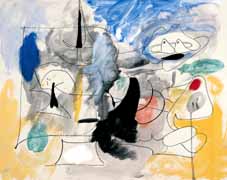 |
| TOP-DRAWER ARSHILE GORKY--Untitled, by Arshile Gorky, 1945-1946. Ink and wash on paper. Private collection. |
·ARSHILE GORKY:
A Retrospective of Drawings
[Closing February 15, 2004]
There are 140 seminal drawings by Arshile Gorky on view at the Whitney. Not only is each work striking in its own right, but, collectively, they document his development as an artist: the changes in his style and "visual vocabulary," as the museum aptly phrases the content of his intriguing later abstractions. There is some visual evidence—or suggestion—that his early adventures in abstraction were inspired by landscapes and objects in the real world. But hunting for corollaries between Nature and Art is almost beside the point with Gorky. As a young and obviously very talented Armenian immigrant, Gorky was already something of an artist-intellectual. And he much admired the drawing skills of the great Ingres. This informed his early portraits. Later he flirted with Cubism, and during the Great Depression, he even worked with Art Deco images for a WPA mural. But—as with Philip Guston, on view at the Met—he moved onward into Abstraction.
This show moves to the Menil Gallery in Houston soon, where you can also see the Post-Modernist ENRON complex.
·New at the Frick Collection:
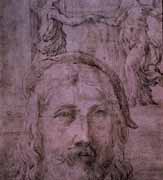 |
| PARMIGIANINO HIMSELF--Self-portrait of artist at Frick Collection. |
·A BEAUTIFUL and GRACIOUS MANNER:
The Art of Parmigianino on View
[Closing April 18, 2004]
On one aspect of the marvelous drawings of Parmigianino all the critics of his age and later could agree: he had a wonderful Grace in all his eloquent sketches. This year is the 500th anniversary of the birth of Girolamo Francesco Maria Mazzola—who took his professional name from his native city, Parma. To celebrate, the Frick has joined with the National Gallery of Canada to make his works better known. The fifty-one astonishing drawings now on view at the Frick will be their only exposure in the United States. Although he lived only 37 years, Parmigianino packed a lifetime of artistic insight and wisdom into those decades, beginning as a youthful prodigy. He escaped the Sack of Rome in 1527 by ransoming his life with some of his drawings.
Among the delicate yet powerful—and always graceful—drawings on view at the Frick are his Sleeping Man, Circumcision, St. Christopher, and Saturn and Philyra. In addition, some of his small paintings are presented, but, curiously, they don't have quite the power of the drawings.
Brilliant examples of Parmigianino's artistry are on loan from the collections of Queen Elizabeth II, Kunsthalle Hamburg, the British Museum, the VandA, the Ashmolean, Chatsworth, Madrid, Budapest, Parma, and even Melbourne, Australia.
·Cinema History at the Guggenheim:
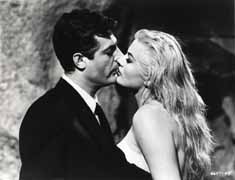 |
| "La Dolce Vita" by Federico Fellini. Marcello Mastroianni and Anita Ekberg. |
·FELLINI!
[Closed January 14, 2004] Many of Federico Fellini's American film-fans would be very surprised to discover how he began his infatuation—and later involvement—with the cinema. Had they had the good fortune to be in New York from November to January, they could have reveled in the Master's brilliant drawings—which actually helped launch his professional career.This fascinating show at the Guggenheim was also the occasion for a film-retrospective of such masterworks as Giulietta degli spiriti, Le notti di Cabiria, Amarcord, E la nave va, I vitelloni, and, of course, La strada and La dolce vita. Plus some footage never used in Fellini films, as well as films about him and films of interviews with him.
Astonishing are Fellini's early caricatures of Hollywood stars. These he did in exchange for free admission to local cinemas in his boyhood town of Rimini. Such bold and amusing, even revelatory, sketches led to employment as a cartoonist and caricaturist for papers and magazines. From journalism, it was an easy transition to script-writer, and film-director.
Among the many drawings on display at the Guggenheim were sketches Fellini made to show how scenes in his movies should be set, manipulated, and shot, He had a ready eye, as well, for interesting faces and bodies. Even film-extras would catch his eye as inspirations for characters in films. Among the objects on view were several books of his drawings for films which were finally never made—but instead became captured between hardcovers.
There was no indication at the Guggenheim that this exhibition would travel elsewhere in the United States, but it certainly should have an extended life.
·Dash Off to the Dahesh:
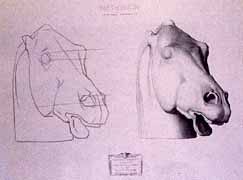 |
| LEARN TO DRAW--Charles Bargue's Parthenon Horse-head as a model for students of Academic Art. |
·CHARLES BARGUE: The Art of Drawing
[Closing February 8, 2004] In the Pantheon of Academic Artists you may search in vain for a statue or even a bust of Charles Bargue. Yet this brilliant artist laid the foundations for many a celebrated career in 19th century French painting. The basis of this development was his seminal Cours de dessin, a published course in drawing, which culminated in three parts. The great Academic painter, Jean-Léon Gérome, collaborated with Bargue on this important training resource.Many of the impressive works on display at the Dahesh were created for the Cours de dessin and are presented as lithographs. But there are also other sketches and oil-paintings by Bargue. His influence on painters of his day and after is demonstrated by works by Picasso and others.
This exhibition is both important and instructive, not only for its introduction to many of Bargue's artistic talents. But also for its demonstration of the way in which Academic painters and sculptors were trained in 19th century France. Long before Abstract Expressionism became the summit of artistic achievement, the Academicians believed that the goal of an artist was the Imitation of Nature. Landscapes, of course, but more importantly, the depiction of the Human Body.
Beginning art-students sketched from plaster-casts, graduating to copying Master Drawings, and finally actually drawing nude models. Bargue's design-course took students through these stages. Even Vincent Van Gogh copied Bargue's' plates from Part III of the course many times, to gain a better understanding of figure-drawing.
Among Bargue's works at the Dahesh are Angel Blowing a Trumpet, after Michelangelo, Arm of Moses, also after Michelangelo, the Belvedere Torso, and a lithograph of that famed horse's head from the Parthenon.
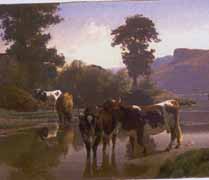 |
| FROM
ROSA BONHEUR'S HORSE-FAIR TO BROTHER AUGUSTE'S COWS--Cattle by a Lake on view at Dahesh Museum. |
·REFRAMING ACADEMIC ART:
Masterworks of the Dahesh Museum
[Closing February 8, 2004]
This title does not mean that the Dahesh has put new frames around old Academic Masterpieces. Rather, it celebrates the addition to the permanent collection now on view on Madison Avenue of 50 more artworks. Notable among these—which represent various media—are works by the Bonheur Family, Rosa and her two brothers, Auguste and Isidore. Auguste Bonheur's painting of Cattle by a Lake certainly fulfills the Academic requirements of Imitating Nature. There are also drawings by Flandrin, Cabanel, Robert, and Doré. As well as sculptures by Bayre, Monti, Mercello, and Dalou. All of these newly displayed works join the previously-sited sculptures, paintings, and drawings at the Dahesh as exemplars in how 19th century artists were trained, what their goals and subjects were, and how they developed on the road to Modernism.
This helps explain and demonstrate to visitors to the Dahesh that Academic or Salon Art was not an ossified tradition, frozen in time, without possibilities or inducements to experiment, development, and change.
·Fun for Kids at American Museum of Natural History:
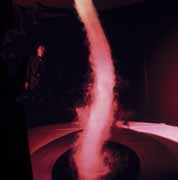 |
| MINI-TWISTER
AT AMERICAN MUSEUM--Popular EXPLORATORIUM© hands-on display for kids. |
·EXPLORATORIUM© AMNH
[Closing August 15, 2004] Even adults will have fun at the Exploratorium© at the American Museum. But they will have to wait their turns, after their own kids and every school-class in New York City has had a chance to play with the 35 intriguing and impressive scientific hands-on exhibits on loan from San Francisco.The Bay City's Exploratorium© has long been a major attraction in the Marina. It is housed in one of the great exhibition buildings flanking the Bernard Maybeck Palace of Fine Arts, all fortunate survivals of the Pan-Pacific World's Fair of 1915.
Only until mid-August, are these 35 hands-on attractions going to be available in New York. But they are so certain to prove of endless fascination to kids that the American Museum might well think about replicating them for a permanent installation. The new Children's Museum in St. Paul, Minnesota, has versions of some of these displays in action right now. Both grown-ups and children in the Twin Cities are standing in line to experiment with scientific principles made visual and tactile.
Among the inter-active displays are the Tornado—a whirling spiral of mist; the Landfall—in which colored sands sift in a great plastic globe to create amazing dream-landscapes; the Confused Sea; the Kaleidoscope—in which you will see endless multiple vistas of Yourself; the Turbulent Orb; the Coriolis Fountain—where you can watch flowing water curve; the Satellite Orbit Simulator; the Rift Zone; the Aeolian Landscape; the Momentum Machine; the Sea of Clouds; the Pendulum Snake, the Coupled Pendulums, the Rotating Pendulum, and the Magnetic Pendulum, and such oddities as Want a New Nose?
Kids can have a go at all of the displays, waiting their turns. Or they can choose one of four special paths: Earth Processes, Rotation, Mirrors and Illusions, and Pendulums. The various displays are largely the ingenious and artistic creations of San Francisco-based Ned Kahn and Shawn Lani. In the Theodore Roosevelt Rotunda of the museum, there is also an installation pumping Cloud Rings twenty feet into the air!
This multi-faceted attraction is, in effect, extended with the hands-on Discovery Room and other AMNH exhibitions illustrating the laws and principles of nature and science. Among these: the Gottesman Hall of Planet Earth and the Cullman Hall of the Universe. And there is a spacious gift-shop with a variety of colorful books, games, and kits to continue the Exploratorium experience at home. Kids can learn Consumerism as well as Science at the American Museum!
·Attention, Aeneas! New Construction in Troy [NY]:
·EMPAC Target Date: Spring 2007:
New Experimental Media and Performing Arts Center
Planned for Rensselaer Polytechnic Institute Upstate
Following closely on the media-admiring opening of the Frank Ghery-designed arts-complex at Bard College upstream on the Hudson River comes the announcement of a possibly even more unusual and state-of-the-art arts-experiment center in Troy, New York. Where they know enough to be wary of Wooden Horses! For New York City residents interested in new developments in the arts—but without wheels—it's frustrating to realize how many really interesting arts-destinations are now mid-state and upstate. There's that spacious ArtPark at Storm King and the new Dia Foundation center somewhere out in the New York hinterlands, not to overlook the arts-attractions of Cooperstown, Rochester, Syracuse, and Buffalo.
The new arts-facility in Troy has already been christened EMPAC, and it's to be an important link between arts-experimentation and the various schools and departments of Rensselaer Polytechnic Institute, one of the jewels in the Trojan Crown.
If the completed complex—designed by London's Nicholas Grimshaw and Partners—is as stunning as it looks in EMPAC's state-of-the-art press-kit, it will be well worth chartering a bus when it opens in 2007 to travel to Troy and check it out.
The new Experimental Media and Performing Arts Center is intended both as a "signature work of architecture" and also as a "tool for programs." With artists-in-residence attempting to create new works or events linked to developing technologies, Rensselaer audiences will have "opportunities that are nowhere else available under a single roof."
Audiences in Troy may prove to be the key to a successful combustion in this arts/architecture/technology formula. Without great audiences, great performances seldom occur.
The EMPAC center will include a 1,200-seat concert hall, a 400-seat theatre, three multi-purpose studios of varied sizes, plus artists' studios and recording, editing, and post-production facilities. It should not be necessary to point out that new performance-spaces do not guarantee memorable cutting-edge arts-adventures. They can encourage experiment, but they are not in themselves Catalysts of Greatness.
EMPAC will be under the supervision of Johannes Goebel, formerly Director of the Institute for Music and Acoustics at Karlsruhe's Center for Art and Media in Baden-Württemburg. Decades ago, the late Billy Kluver was intent on wedding technology and performance, but not much came of that. Perhaps—given the fascination of potential younger audiences with Living on the Internet—the time has come for technology-based performances?
For more information, Rensselaer Poly has an e-mail address: empac@rpi.edu
·At UC/Berkeley's Historic Bancroft Library:
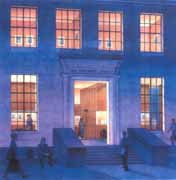 |
| UC/BERKELEY'S BANCROFT LIBRARY--Architects' sketch post-seismic retrofitting preserves neo-classical facade |
·Earthshaking Seismic Renewal
For Centennial Celebrations
Every year, the University of California's Bancroft Library makes its remarkable
collections known in New York with an evening at the prestigious Knickerbocker
Club on Fifth Avenue. Being invited inside this historic building is an experience
in itself, especially for those like your reporter who haven't a prayer of being
bid to membership in one of Manhattan's senior private clubs.
The purpose of such Bancroft Library evenings on one level is to discuss the progress on such projects as the on-going publication of the Mark Twin Papers, the Regional Oral History project, the research in the Tebtunis Papyri Collection, studies in Rare Books and Manuscripts, or additions to the remarkable collection of historical pictures of California and the West.
On a lesser—but immediately more important—level, California Alums and Friends of the Bancroft are alerted to funding needs of the Library. Very soon, the Bancroft's considerable holdings will have to be taken off the shelves and out of the drawers while the Library is retrofitted to protect it against Earthquake damage or destruction.
This will prove awkward for researchers like your scribe, who soon will need to gather a series of Gold Rush Era illustrations for a collection of Pioneer Dramas of the Old West. The Bancroft Library is the finest repository of such sketches and prints.
Long, long ago, I was hunting in the extensive Bancroft California newspaper files for leads on the Forty-Niner story of Archy Lee, a Negro slave who escaped from the South, only to have his beloved master try to take him back from Sacramento and San Francisco to re-sell in the South. One of the dividends of that successful search was a full front-page account of the first view of Yosemite Valley by white men, led there by an Indian guide. This was published on the Fourth of July in a Tulare newspaper which no longer publishes.
In turn, I have made my own small contribution to the Bancroft Library—not only in money—but also in historical artifacts! My great-uncle Dr. Arthur Dangerfield—having impaired his health in harsh Edinburgh winters—was advised to emulate Theodore Roosevelt's The Strenuous Life and go to the American West and work on a cattle-ranch. There, in the High Sierras—on the Black Brothers ranch, next to the Loney Brothers ranch—he became known as "The Limey Cowboy." His journal of this adventure—once broadcast on the BBC—was published by the American Museum in Bath, as edited by your reporter. A copy is also in the Bancroft's collections.
Several years later, when Uncle Arthur had completed medical studies at Edinburgh University—but had no possibility of being able to buy a practice, as was then the custom in the UK—he returned to California, sitting his first day of the Medical Licensing exam on 17 April 1906. That evening he went to the San Francisco Opera to hear Enrico Caruso in Carmen. Later in the night—18 April 1906—San Francisco fell down and caught fire. Dr. Dangerfield was immediately certified a surgeon and put in charge of the Chinese Refugee Camp in the Presidio by General "Black Jack" Pershing. After Uncle Arthur died, his widow gave me Pershing's General Orders—in Chinese—and other artifacts and photos of his time in San Francisco and his later medical practice in North San Juan. These are now in the Bancroft Collections. Including a wooden fan that concealed a knife, which an angry Chinese actually drew on the good doctor, who disarmed him.
Uncle Arthur's Quake Journal memoir of that notable urban disaster—introduced and edited by your reporter—was published in San Francisco Magazine, as well as by Bath's American Museum. His Western saddle, bridle, spurs, and lariat from his stint as a cowboy are now in the Bath Museum. [I saw no point in bringing them back to California from England, where they are far more of a curiosity!]
At least one more California History item in my New York collection is targeted for the Bancroft when I shuffle off to that Great Press-Preview in the Sky. This is a yard-long color lithograph of San Francisco in Flames, published in May 1906. I found this in London's Friday Caledonia Market some forty years ago. I had never seen this image of huge red flames leaping from all of downtown San Francisco before. Nor, apparently, had Bancroft Librarians. The woman who sold it to me did not know its possible value, as she was selling it only for its oak frame. I took the litho and gave her the frame to resell.
The Bancroft—which is housed in the much larger Charles Franklin Doe Main Library of UC/Berkeley—was founded by the acquisition of the large collection of California and Western historical materials amassed by San Francisco bookseller Hubert Howe Bancroft. With the aid of these accounts—and some hard-working assistants—Bancroft was to publish a definitive multi-volume History of California.
At the Knickerbocker Club, we were to have heard from Joan Didion. Her manuscripts—along with those of such other California authors as Jack London, Frank Norris, and Maxine Hong Kingston—are preserved in the Bancroft. Unfortunately, she had to cover the Kobe Bryant Trial—which may give you some idea of the order of priorities for Certified American Intellectuals. But then, her brother-in-law, Dominic Dunne, had helped his own authorial career immensely by covering the O. J. Simpson Trial! [On another California Note, O. J. grew up in the Projects just behind the San Francisco War Memorial Opera House!]
In the event, Bancroft Librarian Charles Faulhaber provided an admirably well-informed replacement speaker: himself!
For more information about Bancroft holdings and projects, the Internet address is: http://www.lib.berkeley.edu/BANC/
·Seeing Cincinnati: Queen City Arts on Parade:
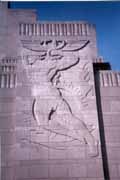 |
| MERCURY
IN FLIGHT--Art Deco relief on facade of Union Terminal in Cincinnati. Photo: ©Glenn Loney 2004. |
·ART DECO UNION TERMINAL:
Transformed into Cincinnati Museum Center
The only trains you can now take from Cincinnati's magnificently Art Deco Union
Terminal arrive and depart in the small hours of the night. Sic Transit/Sick
Transit!
Fortunately, this impressive edifice has been saved from demolition and restored to its former glories—including a Scripps-Howard Newsreel Theatre—to become the teeming home of a group of museums, largely oriented to the interests of school-children and teens who want to know more about Science, Industry, History, and Culture.
Among the Center's restored glories are the handsome Art Deco Murals of Winold Reiss, celebrating both Cincinnati and Ohio History. Cleveland's Theatre Square also has some outstanding Reiss Deco Murals.
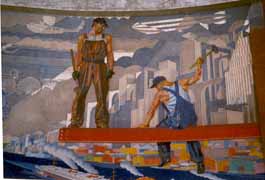 |
| BUILDING
THE MODERN QUEEN CITY--Detail of Winold Reiss's Art Deco Mural in Cincinnati's
Union Terminal Lobby. |
Major museum components of the Terminal Center include the Cinergy Children's Museum, with hands-on exhibits; the Cincinnati History Museum, with some fascinating dioramas; the Museum of Natural History and Science, and the Lindner Family OMNIMAX Theatre.
If you are planning a visit to Cincinnati, do not miss this great work of Deco architecture nor its component museums. For more info: www.cincymuseum.org
·On View at Cincinnati Art Museum:
Cincinnati glories in the nickname of "The Queen City," though it's unclear which even greater mid-western metropolis should be called The King City. [There is a King City in California, but there is nothing regal about it. Maybe Memphis qualifies as birthplace of Elvis The King?]
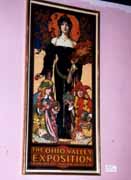 |
| ART NOUVEAU
IN OHIO--1924 Poster in Cincinnati Art Museum. Photo: ©Glenn Loney 2004. |
As befits an American urban polity which is fiercely proud of its history and heritage, the Queen City has its fair share of Antiquities and Old Masters. They are housed in the handsome, if sprawling, Cincinnati Art Museum. Note the word-order in that name! More pretentious places, such as Brooklyn, would have called its major arts-museum The [name of city] Museum of Art. That has a more majestic ring to it, but Cincinnatians are apparently loath to crow about their cultural riches.
Nonetheless, the eclectic collections of the Art Museum are impressive, if sometimes quixotic, largely representing the varied tastes of wealthy 19th century citizens on the Grand Tour. Currently, some of the most interesting treasures of the Museum are on loan to the American Museum of Natural History, where they are fundaments of the marvelous exhibit: PETRA: Lost City of Stone.
·The New CINCINNATI WING
The handsomely illustrated brochure for the newly inaugurated Cincinnati Wing of the Museum is sub-titled "The Story of Art in the Queen City." This richly visually documented narrative is fascinating as well as instructive. And useful to citizens, students, and tourists alike.In fact, the brochure notes, not immodestly, that: "Few cities can boast of such a distinguished tradition in the arts, let alone one that is of national and, in some cases, of international significance."
The artworks, antiques, and artifacts on display are organized into five thematic presentations. The Shifting Frontier is the first of importance as Cincinnati was founded in 1788 as a frontier outpost. But the Way West soon pushed onward, with the city rapidly growing in population, industry, and commerce. Instead of a settlement on the American Frontier, it became known as the Gateway to the West. Cincinnati artist Henry Farney [born 1847] was able to paint Native Americans and their ways of life from first-hand experience.
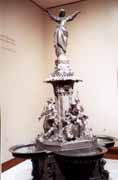 |
| MODEL
FOR MAJOR DOWNTOWN FOUNTAIN--Symbols swarm on Victorian sculpture in Cincinnati
Wing of Art Museum. Photo: ©Glenn Loney 2004. |
Identity is another thematic foundation, for immigrant and religious groups created distinctive artworks and objects which defined and echoed their customs and qualities. Patronage is another theme, without which the Museum would be poor indeed. On view is the handsome model for an imposing example of Victorian sculpture, the Tyler Davidson Fountain, which is one of the most important historical monuments in downtown Cincinnati.
The theme of The Rise of Industry is most appropriate, as Cincinnati was second only to Philadelphia as an American manufacturing center. Its ready access to materials, its many factories, and its easy access to the Ohio River made this possible. Furniture-design and manufacture became very important, and the Museum's new wing shows some stunning examples of elegantly carved wood furniture.
Influenced by the Aesthetic Movement in England, local artists also excelled in the design and decoration of ceramics. Most famous was the Rookwood Pottery, atop Mount Adams. Genuine Rookwood objects are now worth a great deal of money.
The fifth and final theme of the new wing is Art Education, documenting the contribution of such artists as Frank Duvenek and James Henry Beard. There were two influential 19th century art institutes, one of which has become the Art Academy of Cincinnati, a Siamese-twin of the Museum.
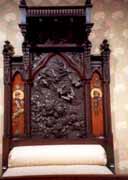 |
| CINCINNATI
WOMEN ARTISTS--Elaborate Pitmann bedstead, carved by Adelaide Nourse Pitmann
& painted by Elizabeth Nourse. Photo: ©Glenn Loney 2004. |
·REDEFINING THEIR SPHERE:
Women Artists in Cincinnati/1850-1900
This attractively designed show is effectively a pendant of the treasures on
view in the Cincinnati Wing, with some overlaps. Not only is Maria Longwood
Nicholas Storer celebrated as the gifted founder of the Rookwood Pottery, but
her artistic rival, Mary Louise McLaughlin, is shown in all her ingenious brilliance.
The paintings of Lily Martin Spencer and Elizabeth Nourse are striking testimony to the talents and vision of the best women artists in the Queen City. And the wood-carving skills of Adelaide Nourse Pitman are notable. The Pitman Bedstead, with its complicated decorations and design, is a tribute to the talents of three artists—one of them a man. Benn Pitman designed, Adelaide carved, and Elizabeth Nourse painted this remarkable piece of Aesthetic Movement furniture.
·EXTRAORDINARY GIFTS:
Proctor and Gamble Donates 78 Paintings by Local Artists
It might come as a surprise to citizens of Chicago or San Francisco, but Timothy Rub, Director of the Cincinnati Art Museum, insists: "There are few places in this country that can boast of an artistic heritage as rich and significant as Cincinnati." To document and illustrate that, the city's great soap-manufacturers, Proctor and Gamble, have assembled an impressive collection of artworks by Cincinnati painters. Some of them, like Frank Duvenek, are known beyond the banks of the Ohio. Others, like Robert Henri, fled to New York or abroad.
While some of the paintings are vivid, even imaginative, records of the life and times of Cincinnati and its citizens, others provide a wider overview of the developments over a century of American painting. Among the artists represented in PandG's gift to the museum and the city are: Elizabeth Nourse, Alexander Wyant, Bessie Hoover Wessel, Henry Mosler, Lewis Henry Meakin, Robert S. Duncanson, James Roy Hopkins, Robert Frederick Blum, James Henry Beard, John Henry Twatchman, Dixie Selden, William Louis Sonntag, Frank Harmon Myers, and, of course, Frank Duvenek and Robert Henri.
Among the canvases with local subjects are: Mount Auburn Snow, Eden Park, and Winter in Cincinnati. More exotic locales are invoked by Moorish Boy, Venice, the Grand Canal, and Cauliflower, Cagnes-sur-Mer.
·Zaha Hadid's First American Commission:
Lois and Richard Rosenthal Center for Contemporary Art
The London-based but Iranian-descended innovative architect Zaha Hadid has in recent years exhibited in major museums some astounding drawings for projects which are artworks in themselves. Some have seemed almost unrealizable, given current construction technologies. Her new Contemporary Arts Center in Cincinnati, however, demonstrates that a variety of her innovative approaches to exteriors and interiors can indeed be made reality. This handsome Post-post-Modernist structure is almost a sliver-building on its narrow site on the corner of a major downtown intersection
Architectural and cultural commentators have written rave-reviews. The New York Times' critic noted, in part: "…the most important American building to be completed since the end of the cold war."
Like the Frank Lloyd Wright Guggenheim and the Daniel Liebeskind Berlin Jewish Museum, Hadid's art/activity museum/center is in itself an artwork, a sculpture inside and out. Stairs and ramps are themselves special spatial sculptures.
All the artworks on display—some of which seem integrated into the building's fabric—are as innovative and cutting-edge as the structure itself. There is even a special floor, the UnMuseum, in which all the artworks are designed for children.
Yes, Virginia, there is a Website: www.ContemporaryArtsCenter.org
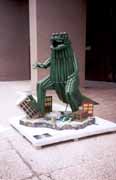 |
| BATS
INCREDIBLE!--Louisville Slugger Bats transformed into Godzilla sculpture. Photo: ©Glenn Loney 2004. |
·BATS INCREDIBLE!
ArtWorks Promotes Bat-Sculptures
Flying Pigs were yesterday in Cincinnati… When New York City was swamped with
Cows of all colors and Berlin was invaded by painted Bears, citizens of that
great mid-western city on the Ohio River were busy painting Pigs with Wings
with all sorts of fantastic colors and designs. This 2000 AD arts-adventure
was called the BIG PIG GIG.
But the Year of Our Lord 2003 was celebrated in Cincinnati with the opening of The Great American Ball Park, home to the Cincinnati Reds, said to be the "oldest professional baseball team" in the nation. This new/old stadium of 42,000 seats boasts closer views of the playing field than most American stadia can claim.
So what could be more appropriate than a sculptural-salute from the city's cultural sector? This time round, not Pigs but Bats. This community artistic-initiative was named BATS INCREDIBLE! Art for the Athletic Supporter. Its "Major League Bat Map" was titled COVERING THE BASES.
The famed Louisville Slugger Bat factory donated some 11,000 bats for basic materials, from which 200 artists fashioned bat-sculptures to be sited on some 65 city blocks. The project was directed and implemented by ArtWorks, an arts-based employment and job-training program for area youths. Its signature-vehicle was the Bat-Mobile, a Chevy pickup covered with Astroturf, bats, balls, and a baseball bobble-head.
Among the many unusual and eye-catching sculptures were Grand Sam—Uncle Sam made out of red-white-and-blue-painted bats; Alphabat, Bat-B-Q, ComBat-Hunger, Going Batty, Batty Boop, Batsy Ross, Batue of Liberty, Batwurst, Bat-lerina, and on and on and on… Some 150 of these always colorful and often amusing bat-sculptures were finally sold at auction for various charities in the Union Terminal Grand Foyer.
Copyright and Copy—Glenn Loney 2004
[Loney]
Copyright © Glenn Loney 2004. No re-publication or broadcast use without proper credit of authorship. Suggested credit line: "Glenn Loney, Curator's Choice." Reproduction rights please contact: jslaff@nymuseums.com.
Return to Curator's Choice Table of Contents